Innovative hydrogel-based therapies for ischemia-reperfusion injury: bridging the gap between pathophysiology and treatment
IF 8.7
1区 医学
Q1 ENGINEERING, BIOMEDICAL
引用次数: 0
Abstract
Ischemia-reperfusion injury (IRI) commonly occurs in clinical settings, particularly in medical practices such as organ transplantation, cardiopulmonary resuscitation, and recovery from acute trauma, posing substantial challenges in clinical therapies. Current systemic therapies for IRI are limited by poor drug targeting, short efficacy, and significant side effects. Owing to their exceptional biocompatibility, biodegradability, excellent mechanical properties, targeting capabilities, controlled release potential, and properties mimicking the extracellular matrix (ECM), hydrogels not only serve as superior platforms for therapeutic substance delivery and retention, but also facilitate bioenvironment cultivation and cell recruitment, demonstrating significant potential in IRI treatment. This review explores the pathological processes of IRI and discusses the roles and therapeutic outcomes of various hydrogel systems. By categorizing hydrogel systems into depots delivering therapeutic agents, scaffolds encapsulating mesenchymal stem cells (MSCs), and ECM-mimicking hydrogels, this article emphasizes the selection of polymers and therapeutic substances, and details special crosslinking mechanisms and physicochemical properties, as well as summarizes the application of hydrogel systems for IRI treatment. Furthermore, it evaluates the limitations of current hydrogel treatments and suggests directions for future clinical applications.

基于水凝胶的缺血再灌注损伤创新疗法:弥合病理生理学与治疗之间的差距
缺血再灌注损伤(IRI)通常发生在临床环境中,尤其是在器官移植、心肺复苏和急性创伤恢复等医疗实践中,给临床治疗带来了巨大挑战。由于药物靶向性差、疗效短、副作用大,目前治疗 IRI 的全身疗法受到限制。由于水凝胶具有优异的生物相容性、生物可降解性、优良的机械性能、靶向性、控释潜力以及模仿细胞外基质(ECM)的特性,因此水凝胶不仅是输送和保留治疗物质的优良平台,还能促进生物环境培养和细胞招募,在 IRI 治疗中展现出巨大的潜力。本综述探讨了 IRI 的病理过程,并讨论了各种水凝胶系统的作用和治疗效果。通过将水凝胶系统分为输送治疗药物的储层、包裹间充质干细胞(MSCs)的支架和模拟 ECM 的水凝胶,本文强调了聚合物和治疗物质的选择,详细介绍了特殊的交联机制和理化性质,并总结了水凝胶系统在 IRI 治疗中的应用。此外,文章还评估了当前水凝胶疗法的局限性,并提出了未来临床应用的方向。
本文章由计算机程序翻译,如有差异,请以英文原文为准。
求助全文
约1分钟内获得全文
求助全文
来源期刊

Materials Today Bio
Multiple-
CiteScore
8.30
自引率
4.90%
发文量
303
审稿时长
30 days
期刊介绍:
Materials Today Bio is a multidisciplinary journal that specializes in the intersection between biology and materials science, chemistry, physics, engineering, and medicine. It covers various aspects such as the design and assembly of new structures, their interaction with biological systems, functionalization, bioimaging, therapies, and diagnostics in healthcare. The journal aims to showcase the most significant advancements and discoveries in this field. As part of the Materials Today family, Materials Today Bio provides rigorous peer review, quick decision-making, and high visibility for authors. It is indexed in Scopus, PubMed Central, Emerging Sources, Citation Index (ESCI), and Directory of Open Access Journals (DOAJ).
 求助内容:
求助内容: 应助结果提醒方式:
应助结果提醒方式:


